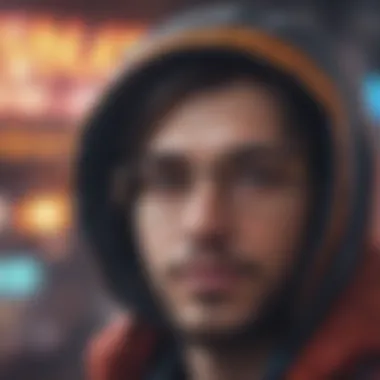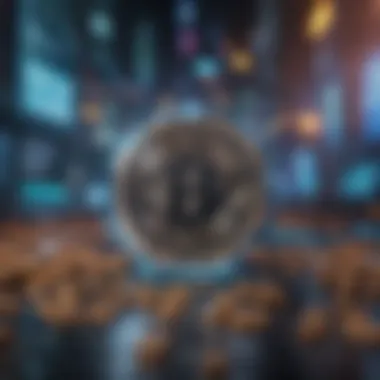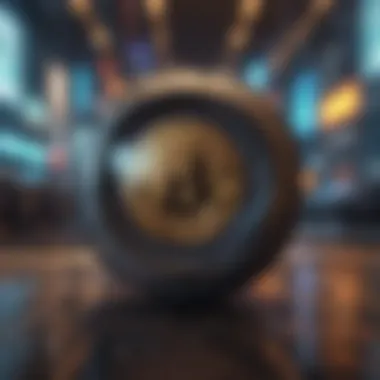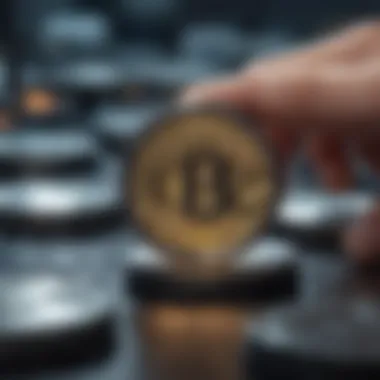Understanding NFT Art: Definition and Creation Process


Intro
In the digital landscape, where traditional art meets cutting-edge technology, Non-Fungible Tokens (NFTs) have emerged as a game-changer. NFT art stands at this intersection, transforming how we understand and engage with creativity in the modern age. Unlike conventional artwork that can exist in physical forms, NFT art resides solely in the digital realm, bringing unique challenges and opportunities to the forefront.
Today, artists and collectors navigate a space that is both exhilarating and complex. The ability to create, buy, and sell digital assets in a way that guarantees authenticity and ownership has rewritten the rules of engagement for creators and investors alike. As we delve into this topic, we'll explore the fundamentals of NFT art, its practical significance, and ultimately how individuals can dive into creating their own digital masterpieces.
Market Overview
To understand NFT art fully, we need to grasp the landscape in which it thrives. This includes recognizing the current trends within crypto markets as well as the factors that influence the prices of these digital assets.
Current Trends in Crypto Markets
The NFT market is often tied closely to broader developments in crypto markets. Recently, we have witnessed a few noteworthy shifts:
- Increased Adoption: Major brands and celebrities are leveraging NFTs for promotions, creating a buzz that entices more investors and artists.
- Diversification of Platforms: While Ethereum has long been the dominant player, various blockchain platforms like Solana, Tezos, and Flow are emerging, offering alternatives with lower fees and quicker transaction times.
- Market Volatility: Price swings in the NFT space can be severe, often influenced by broader economic factors, shifts in consumer interest, and changes in the underlying blockchain technology.
Influential Factors Affecting Prices
Understanding what drives NFT prices is crucial for both artists and investors. Various elements play significant roles in this regard:
- Scarcity and Rarity: Limited edition works or one-of-a-kind pieces can command higher prices due to their unique nature.
- Artist Reputation: Well-known artists or those who have built a strong brand in the digital art space often attract higher bids.
- Market Hype: The buzz surrounding certain pieces can inflate prices, even if the intrinsic artistic value may not justify it.
"NFTs blur the line between digital collectibles and investment assets, challenging traditional notions of art and ownership."
As we move forward, awareness of these factors becomes a valuable asset for anyone venturing into the realm of NFT art. Investors, analysts, and tech enthusiasts must keep an eye on emerging trends and their potential implications on value and collectibility.
Defining NFT Art
Understanding NFT art is crucial in today’s rapidly evolving digital landscape. As more artists and investors flock to the realm of blockchain, recognizing how NFT art functions offers insight into its significance. This section will shed light on what NFTs are, their historical context, key features, and the pivotal role blockchain plays in the world of digital art.
What Are NFTs?
NFTs, or non-fungible tokens, are distinct digital assets verified using blockchain technology. Unlike traditional currencies or cryptocurrencies, each NFT possesses unique identifiers and metadata, setting it apart from other tokens. This uniqueness brings a sense of scarcity, creating value in the digital domain. For example, when an artist creates a digital painting and mints it as an NFT, that specific artwork is one-of-a-kind.
In practice, NFTs can represent various forms of digital creations, like artwork, music, or even tweets. Because of their blockchain foundation, ownership is transparent and immutable. It’s like owning a rare collector's item but in the digital world.
Historical Context of Digital Art
Digital art is not a new concept; it started gaining traction in the 1980s with the rise of personal computing. Artists experimented with software tools, blending traditional art techniques with digital innovation. Yet, owning digital art remained a challenge due to its easily replicable nature. This digitized work was often perceived as less valuable than physical pieces; it was like keeping a fragment of sand from a beach. However, the introduction of NFTs changed that perspective.
As companies and platforms began to facilitate the sale of NFT art in the late 2010s, artists could finally attach proof of ownership to their work. The moment Crista Clough’s digital illustration sold for millions cemented this shift. Digital art emerged from the shadows, gaining recognition as a legitimate artistic medium.
Characteristics of NFT Art
Several features define NFT art, contributing to its allure:
- Scarcity: Each NFT is unique, often represented by a specific number or code that confirms its rarity.
- Ownership: Blockchain technology assigns clear ownership to the buyer, avoiding disputes and fraud.
- Interactivity: Many creators incorporate additional features, such as animations or 3D objects, enhancing viewer engagement.
- Provenance: The blockchain ledger keeps a transparent record of all transactions, allowing potential buyers to track an art piece’s history.
These characteristics not only validate the value of NFTs but also transform the art market as we know it.
The Role of Blockchain in NFT Arts
Blockchain technology underpins the entire NFT ecosystem. It provides a distributed and secure record of transactions, accessible to anyone. Each NFT is linked to a transaction on this ledger, which guarantees authenticity and ownership. Think of blockchain as a stamp of approval; once an artist mints their artwork as an NFT, that piece becomes part of an unchangeable record.


Moreover, blockchain enables artists to earn royalties on secondary sales. If a collector sells the NFT in the future, the artist can receive a percentage of that sale. It’s a game changer for artists looking to build sustainable income streams.
The Emergence of NFT Art
The landscape of art and technology has undergone a seismic shift with the emergence of NFT art. This phenomenon serves as both a reflection and a catalyst of contemporary culture. It's not merely about owning a piece of digital artwork; it's about establishing ownership in a virtual realm where authenticity has historically been elusive. As we delve into the intricate layers of NFT art, we shall navigate through its significance and the wider impacts it has on society.
Why NFTs Matter in Today’s Culture
NFTs, or Non-Fungible Tokens, represent a groundbreaking shift in how art is perceived and valued. They introduce a mechanism that provides provenance to digital content, allowing artists to securely sell their work while retaining ownership rights. This is paramount in today’s digital culture where copying and redistribution are rampant.
Furthermore, they democratize access to art. For example, a digital artist from a small town can now reach a global audience, leveling the playing field against traditional galleries or auction houses. No longer is it just about who you know; it's about the artwork itself.
"The future belongs to those who believe in the beauty of their dreams." – Eleanor Roosevelt
It's also worth noting that NFTs resonate with younger generations who are more accustomed to digital adaptations over physical artifacts. This connection will only cement the relevance of NFTs in modern culture, as we recognize art's shift into an increasingly digital domain.
Major Success Stories in NFT Art
Several notable artists and brands have pioneered the NFT space, creating sensational success stories that now serve as inspiration within the community. Beeple, for instance, transformed perceptions by selling a digital collage for $69 million at a Christie’s auction in 2021. This was a watershed moment for NFT art, validating its place within the larger art market.
Similarly, the band Kings of Leon released their album as an NFT, which allowed fans an innovative way to engage with their music and ownership rights.
- Everydays: The First 5000 Days by Beeple
- Kings of Leon's When You See Yourself
- Bored Ape Yacht Club's Community Building
These cases illustrate not only the feasibility of NFTs as revenue streams but also showcase the creativity involved in conceptualizing how art, music, and community can intersect in novel ways.
The Impact of Social Media on NFT Art
Social media has been a powerhouse in fostering the NFT art movement. Platforms such as Twitter, Discord, and Instagram enable artists to showcase their digital portfolios directly to potential buyers without intermediaries. The ability to connect directly with an audience creates a palpable sense of community.
Moreover, influential figures in the art world often share their thoughts and findings related to NFTs online, generating discussions that further increase visibility and interest. Hashtags like #NFTArt and #CryptoArt have sprung up, linking enthusiasts and collectors across platforms and forming a lively dialogue.
- Twitter Spaces allows for live discussions and networking.
- Instagram showcases artwork visually appealingly.
- Discord communities facilitate interactions among creators and buyers.
In essence, social media serves as both a megaphone and a gallery, allowing artists to curate their digital spaces while encouraging interaction, thereby accelerating the growth of the NFT ecosystem.
Creating NFT Art
Creating NFT art is more than just a modern trend; it's a digital renaissance that merges technology with creativity. For artists aiming to share their work in a space that transcends traditional galleries, understanding how to create NFT art is paramount. This process gives artists the opportunity to not only express their individuality but also to explore new revenue streams in the ever-evolving art landscape. With an intrinsic link to blockchain technology, NFT art provides a unique way to validate the ownership and provenance of digital art pieces, drawing attention from investors and collectors alike.
Getting Started: Tools and Software
To dip your toes into the NFT waters, you need the right tools. The technological landscape can be intimidating, but it doesn’t have to be. Here are some core tools you might want to consider:
- Graphic Design Software: Programs like Adobe Photoshop or Illustrator are excellent for crafting visuals. For those preferring free options, GIMP or Krita are viable substitutes.
- 3D Modeling Software: If you're leaning towards three-dimensional art, Blender is both powerful and free.
- Digital Wallet: Make sure you have a digital wallet that supports cryptocurrencies like Ethereum, which is the most common blockchain for NFTs. Trust Wallet, MetaMask, or Coinbase Wallet are a few examples.
- Minting Platforms: Platforms such as OpenSea, Rarible, or Foundation allow you to mint (create) your NFT once your artwork is ready.
The right blend of tools lays a solid foundation, enabling you to create with confidence.
Conceptualizing Your Artwork
Conceptualization is where the magic starts. Taking the time to develop your idea is crucial. Think about what themes resonate with you, considering current trends, social issues, or personal experiences. Don’t shy away from originality; after all, it’s your unique voice that will captivate an audience.
- Brainstorm: Jot down snippets of inspiration or ideas as they come to you. This can be anything from a color palette to a grand narrative.
- Research: Dive into what others are doing in the NFT space. Knowing what's out there can help refine your vision.
- Audience: Consider who your audience might be. What do they value? Tailoring your concept to your potential collectors can make a difference in how your work is received.
Every artist finds their way differently; the journey of getting from an idea in your head to a tangible piece of art is inherently personal.


Designing Your Digital Piece
Designing your piece involves translating that brilliant concept into a visual format. Whether it’s a still image, video, or interactive piece, you have plenty of options.
- Focus on Quality: High-resolution images and well-crafted designs will stand out in a saturated market. Make sure no detail is overlooked.
- Element of Surprise: Think about how you can provoke thought or emotion. Adding layers, interactive components, or sound can elevate the experience.
- Consistency with Branding: If you're planning to create more NFTs down the line, keep your style consistent to build a recognizable brand.
This phase is crucial; your design is the first point of contact with potential buyers who might decide the value of your art.
Choosing a Suitable Blockchain
Not all blockchains are created equal when it comes to NFTs. The blockchain you choose can affect various factors including fees, environmental impact, and community. Ethereum is the frontrunner, but it’s not the only player.
- Ethereum: Well-established with large marketplaces, but it can be costly due to gas fees.
- Binance Smart Chain: Offers lower fees and faster transactions; it’s a good alternative for beginners.
- Tezos: Eco-friendly, with minimal gas fees; it’s gaining popularity for those conscious about environmental impact.
- Flow: Created with NFTs in mind, it’s user-friendly and works well for collectors.
Choosing the right blockchain tailored to your needs ensures your work not only shines but also thrives in the NFT ecosystem.
"In a world where creativity meets technology, NFT art isn't just an expression; it's a new frontier of ownership and value."
Equipped with your tools, a solid concept, a well-designed piece, and the right blockchain in mind, you’re well on your way to entering the dynamic world of NFT art creation.
Minting Your NFT
Minting an NFT is a crucial stage in the journey of creating digital artwork, transforming static files into unique, tradable assets on the blockchain. This process crystallizes the ownership and authenticity of the digital item, securing its spot within the vast universe of NFT art. Understanding how minting works, the available marketplaces, and the associated costs is essential not just for artists but also for investors and collectors alike. It’s about ensuring that the effort put into creation pays off while upholding integrity in the digital art realm.
Understanding the Minting Process
Minting, in essence, means bringing your artwork onto a blockchain, making it verifiably yours. Think of the blockchain as a digital ledger that documents ownership through a series of interconnected blocks of data. Here’s how it usually rolls out:
- Select the Artwork: This can be anything from a digital painting to a music file or even a meme. The key is to ensure that you hold the rights to the piece.
- Choose the Blockchain: Popular options include Ethereum, Binance Smart Chain, and Tezos. Each has its own rules and processes, so this choice can impact your NFT's visibility and costs.
- Create a Wallet: Before minting, you’ll need a crypto wallet that supports your chosen blockchain. This wallet is where your NFTs will live post-minting.
- Upload the Digital File: Platforms like OpenSea or Rarible allow you to upload your artwork, essentially embedding it into the NFT.
- Fill in Details: Add a title, description, and potentially unlockable content for the buyer, like a high-resolution file or behind-the-scenes material.
- Mint the NFT: This is where you pay a small fee and allow the smart contract to create your NFT on the blockchain.
"In the world of NFTs, minting is akin to signing your name on a canvas; it authenticates your claim to the work."
Popular NFT Marketplaces
When it comes to selling your minted artwork, the choice of marketplace plays a pivotal role in exposure and sales. Each has distinct attributes and communities:
- OpenSea: Often touted as the largest NFT marketplace. Great for visibility but does charge listing fees.
- Rarible: This platform is decentralized and allows artists to create and sell NFTs directly. Artists can earn royalties when their work is resold, adding ongoing income potential.
- Foundation: A more curated space, this marketplace requires an invitation to join, potentially securing a higher caliber of art and buyers.
- Nifty Gateway: Known for its drops and collaborations with big-name artists, it’s a distinctive platform attracting a wide audience.
Choosing the right platform can affect your artwork’s engagement level and how much you can ask for it. Evaluate both the audience and the fees involved carefully.
Gas Fees and Other Considerations
Gas fees can become a significant factor when minting your NFTs. This fee is essentially the cost of processing transactions on the blockchain and varies considerably depending on the network congestion. Here are a few points to ponder:
- Variable Costs: Fees can range from a few dollars to hundreds, particularly on Ethereum, depending on network usage.
- Timing Matters: Minting during off-peak times can help mitigate costs, so keep an eye on the Ethereum network activity.
- Gas-Free Alternatives: Some blockchains, like Tezos, provide more affordable minting options, which can be attractive for new artists.
- Smart Contract Features: When minting, choosing the right features within the smart contract can also influence future sales and royalties.
Taking these elements into consideration will help artists navigate the complexities of minting efficiently. This stage not only represents the final step in creating NFT art but also determines the future trajectory of the artwork in the digital marketplace.
Promoting Your NFT Art
In an era where digital creation holds vast potential yet immense competition, promoting your NFT art becomes not just a choice but a necessity. The digital ownership economy, especially within the realm of NFTs, thrives on visibility. Without it, even the most stunning digital pieces risk becoming mere whispers in a cacophony of creative output. Each artist must navigate this landscape with tactics tailored for engagement and resonance.
Leveraging Social Media for Exposure


Social media acts as a digital gallery, akin to the bustling art fairs of yore. Platforms such as Twitter, Instagram, and TikTok are not just channels for sharing; they are vital ecosystems for communities around NFTs. By showcasing your artwork in snippets or posts, you can spark interest and conversation.
- Twitter Spaces: Engaging in Twitter Spaces discussions can illuminate your art while allowing you to connect directly with potential buyers and fellow artists.
- Instagram Stories: These can showcase the evolution of your work, providing behind-the-scenes glimpses of your creative process.
- Engagement: Responding to comments and messages creates a personal touch and fosters relationships that might translate into art sales.
An effective social media strategy includes a balance of promotion and authenticity. Regular updates that reflect your artistic journey can build a dedicated following.
Collaborations with Other Artists
Teamwork can often lead to unexpected yet rewarding outcomes. Collaborating with other artists can expand your reach significantly, as it merges your audience with another’s. This is akin to cross-pollination, where multiple ideas blend into something fresh and enticing.
Think of joint exhibitions or even collaborative digital pieces that can be minted as NFTs. This approach not only diversifies your portfolio but also enhances visibility. Consider the following:
- Partnering on exclusive NFT drops
- Joint social media campaigns that create buzz
- Physical or virtual events like gallery shows or webinars
Such collaborations enhance credibility and can lead to shared audiences discovering your unique work.
Building a Personal Brand in the NFT Space
In the NFT world, establishing a strong personal brand is paramount. Your brand is more than your art; it's your narrative, your vision, and the way you connect with your audience. A compelling personal brand allows collectors to feel personally invested in your work.
To create an impactful brand, consider:
- Unique Voice: Ensure your communication style is consistent across platforms. This could involve sharing your artistic journey, inspirations, or thoughts on the NFT market.
- Visual Identity: Develop a recognizable aesthetic that mirrors your artistic pursuits. It could be a color scheme, a specific type of imagery, or even your logo.
- Community Engagement: Participate actively in NFT discussions on platforms like Reddit or Discord. Sharing knowledge and insights builds your reputation as an authority within the space.
Legal and Ethical Considerations
The realm of NFT art is not just a vivid gallery of digital creativity, but it also exists within a complex web of legal and ethical frameworks. Navigating these nuances is essential for artists, buyers, and collectors alike. The way individuals interact with NFT art raises significant queries surrounding copyright laws, ownership rights, and environmental ramifications brought about by blockchain technology.
Copyright Issues in NFT Art
One of the foremost concerns in the NFT landscape is that of copyright. Copyright issues aren't straightforward in traditional art; they become even murkier when digital assets like NFTs come into play. When an artist creates an NFT, they aren’t necessarily transferring their copyright ownership to the buyer. The smart contract attached to the NFT usually defines what rights are granted to the buyer.
For example, a buyer might receive the right to display the art but not to mass produce it or alter it in any way. This lack of clarity can lead to disputes down the line, especially if the art earns notoriety. Thus, artists must ensure that their copyright notices are clear before minting their work.
- Key Factors to Consider:
- Ensure your copyright status is stated explicitly in the NFT's smart contract.
- Be aware that sharing or reposting an NFT doesn’t automatically mean purchasing the rights to it.
Understanding Ownership and Rights
Ownership in the NFT space is a concept that goes beyond mere possession. When someone buys an NFT, they're essentially acquiring a token registered on a blockchain, but not all ownership translates to full rights over the artwork. This disparity can confuse both buyers and creators.
The token verifies uniqueness, yet it doesn't inherently signify ownership of the underlying artwork. Consequently, it’s vital for buyers to dive deeper into the terms laid out in the NFT, particularly clauses related to ownership and usage rights.
- Points to Grasp:
- Understand that NFTs serve more as collectibles rather than complete ownership of an artwork.
- Artists can embed unique terms governing how their art can be used in the NFT's code.
The Debate Over Environmental Impact
Environmental considerations surrounding NFTs often spark fiery discussions. The creation and transaction of NFTs typically rely on energy-intensive blockchain networks, which are often criticized for their carbon footprints. This stark reality presents a moral quandary: how can creators and collectors justify participating in an art form that may contribute to environmental degradation?
Some NFT platforms are advocating for more sustainable practices, shifting towards blockchain technologies that consume less energy. Yet, the existing models continue to stir debate among artists and collectors about their ethical duties towards environmental conservation.
"As we walk down this path into the digital art frontier, we must weigh our choices against the backdrop of sustainability."
- Efforts in Sustainability:
- Look for blockchain platforms that utilize less energy-intensive protocols.
- Engage with artists and platforms actively promoting eco-friendly initiatives.
In wrapping up these considerations, acknowledging the legal and ethical facets of NFT art is vital for anyone stepping into this space. It empowers creators and collectors alike, paving the road for more informed decisions in a continually evolving market.















